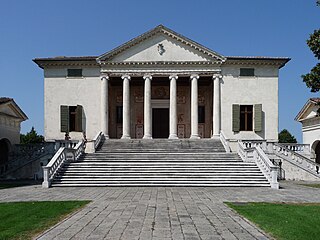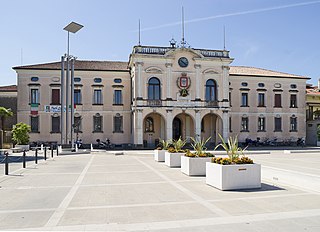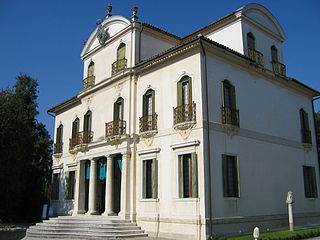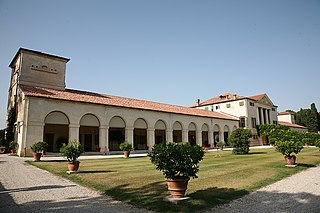
Andrea Palladio was an Italian Renaissance architect active in the Venetian Republic. Palladio, influenced by Roman and Greek architecture, primarily Vitruvius, is widely considered to be one of the most influential individuals in the history of architecture. While he designed churches and palaces, he was best known for country houses and villas. His teachings, summarized in the architectural treatise, The Four Books of Architecture, gained him wide recognition.

The Brenta is an Italian river that runs from Trentino to the Adriatic Sea just south of the Venetian lagoon in the Veneto region, in the north-east of Italy.

Bassano del Grappa is a city and comune, in the Vicenza province, in the region of Veneto, in northern Italy. It bounds the communes of Cassola, Marostica, Solagna, Pove del Grappa, Romano d'Ezzelino, Campolongo sul Brenta, Conco, Rosà, Cartigliano and Nove. Some neighbourhoods of these communes have become in practice a part of the urban area of Bassano, so that the population of the whole conurbation totals around 70,000 people.

Villa Badoer is a villa in Fratta Polesine in the Veneto region of northern Italy. It was designed in 1556 by Italian Renaissance architect Andrea Palladio for the Venetian noble Francesco Badoer, and built between 1557 and 1563 on the site of a medieval castle, which guarded a bridge across a navigable canal. This was the first time Palladio used his fully developed temple pediment in the façade of a villa.

The Nuova Mala del Brenta (NMB), also known as New Brenta Mafia, is a criminal organization based in the Veneto region of Italy. The group is believed to have emerged in the late 1990s as a successor to the original Mala del Brenta, which was active in the area during the 1970s and 1980s.

The Riviera del Brenta is an area of the Metropolitan City of Venice of particular tourist-cultural interest due to the great architectural heritage of the Venetian villas built between the 15th and 18th centuries by the nobles of the Venetian Republic along the river Brenta.

Montebelluna is a city and comune in Veneto, Italy, approximately 50 kilometres (31 mi) northwest of Venice. It has an estimated population of 32,000.

Villa Pisani at Stra refers to the monumental, late-Baroque rural palace located along the Brenta Canal at Via Doge Pisani 7 near the town of Stra, on the mainland of the Veneto, northern Italy. This villa is one of the largest examples of Villa Veneta located in the Riviera del Brenta, the canal linking Venice to Padua. The patrician Pisani family of Venice commissioned a number of villas, also known as Villa Pisani across the Venetian mainland. The villa and gardens now operate as a national museum, and the site sponsors art exhibitions.

Valstagna is a town and comune in the province of Vicenza, Veneto, northern Italy, It is connected to the frazione Carpanè of San Nazario by a bridge and it is accessible by SS47 Provincial Road.The biggest towns nearby Valstagna are Bassano del Grappa, Marostica, Asiago, Trento and Venice.

Camponogara is a town in the Metropolitan City of Venice, Veneto, Italy. It is west of SP13, not far from the nearby Brenta river. Economy is based on the production of wine, including Cabernet and Merlot, and manufacturing of shoes and leather products.

Dolo is a town and comune in the Metropolitan City of Venice, Veneto, Italy. It is connected by the SP26 provincial road and is one of the towns of the Riviera del Brenta.

Fiesso d'Artico is a town in the Metropolitan City of Venice, Veneto, Italy. The town is connected by the SR11, and is part of the Riviera del Brenta.

Mira is a comune (municipality) in the southern Veneto, northern Italy. It is part of the Metropolitan City of Venice and the 11th most populous comune of Veneto.

Vigonovo is a town in the Metropolitan City of Venice, Veneto, Italy. It is south of SR11.

The Villa Widmann, also called Widmann-Rezzonico-Foscari, is a villa at the shores of the river Brenta located in the small town of Mira, between Venice and Padua.

Ettore Tito was an Italian artist particularly known for his paintings of contemporary life and landscapes in Venice and the surrounding region. He trained at the Accademia di Belle Arti in Venice and from 1894 to 1927 was the Professor of Painting there. Tito exhibited widely and was awarded the Grand Prize in painting at the 1915 Panama–Pacific International Exposition in San Francisco. In 1926 he was made a member of the Royal Academy of Italy. Tito was born in Castellammare di Stabia in the province of Naples and died in Venice, the city which was his home for most of his life.

The Museo Rossimoda della calzaturatrans. Rossimoda Museum of the Shoe is located in Villa Foscarini Rossi at Stra, which lies along the Riviera del Brenta in the mainland portion of the province of Venice, Italy.

The Cismon is a mountain stream in northern Italy, the main tributary of the Brenta River. The torrent flows from the Dolomites mountains in the Trentino Alto-Adige region through the plains of Venetian territory to the bigger Brenta River, which in turn flows into the Adriatic Sea in the Gulf of Venice.

The Villa Loredan at Stra is an early 16th-century villa of the noble Loredan family located in the town of Stra, on the Brenta river in the Veneto region of northeast Italy.

A barchessa is a rural service building, typical of the architecture of Venetian villas. The concept was created and popularized by architect Andrea Palladio. A barchessa contains the working portions of the estate, separately from the central body of the villa. Barchessas were characterized by a long arcade with high round arches and used for services including kitchens, farm staff, stables, and barns. As interpreted outside of Italy, the barchessas evolved to become defining elements of Palladian architecture.




















